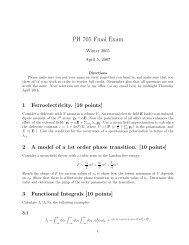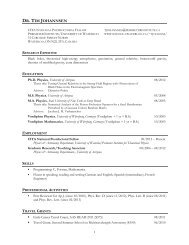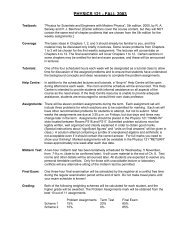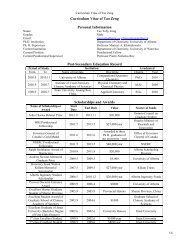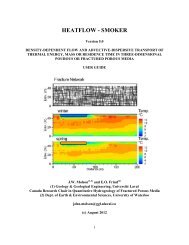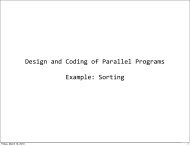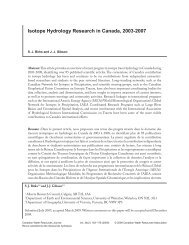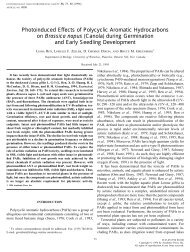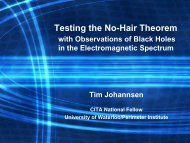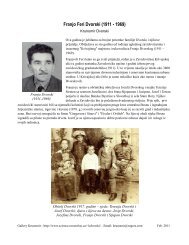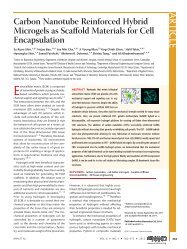POLYMIN - University of Waterloo
POLYMIN - University of Waterloo
POLYMIN - University of Waterloo
You also want an ePaper? Increase the reach of your titles
YUMPU automatically turns print PDFs into web optimized ePapers that Google loves.
<strong>POLYMIN</strong> 2005<br />
Solution Strategy<br />
<strong>POLYMIN</strong> uses two-step sequential physical-chemical coupling (Walter et al, 1994a) to solve<br />
the reactive transport equations. In this approach, the transport equation is split into a physical<br />
step, and a chemical step:<br />
Step 1 (physical)<br />
n+1 phys<br />
equil<br />
( C k - Ck<br />
) δ(t + ∆t)= Rk<br />
δ(t + ∆t)<br />
k = 1,...,N c<br />
(18)<br />
Step 2 (chemical)<br />
( C<br />
- C<br />
∆t<br />
phys<br />
k<br />
n<br />
k<br />
)<br />
= L( C<br />
k<br />
)<br />
n+1/2<br />
k = 1,...,N<br />
c<br />
(19)<br />
where C k phys is the concentration <strong>of</strong> component k at the end <strong>of</strong> the physical step, L represents the<br />
transport operator, δ is the Dirac delta, and n, n+1/2, n+1 relate to the beginning, midpoint, and<br />
end <strong>of</strong> the time step ∆t, respectively.<br />
The transport model is coupled to the oxygen diffusion and pyrite oxidation modules following<br />
the sequence shown in Figure 1. The simulation over a transport time step ∆t begins with an<br />
iterative solution to the oxygen diffusion and reactive core equations which liberates H + , SO 4 2+ ,<br />
Fe 2+ and Fe 3+ . Because <strong>of</strong> the nonlinearity for these coupled reactions, the solution is performed<br />
over a smaller sub-time step ∆t oxid , typically 1/10 th - 1/50 th <strong>of</strong> the transport time step ∆t. These<br />
calculations are very rapid and do not significantly affect the total execution time. The reactive<br />
products are accumulated over each sub-time interval and are added to the existing nodal<br />
concentrations just before the chemical equilibration step.<br />
Following convergence <strong>of</strong> the diffusion and reactive core equations, a second iterative sequence<br />
begins for the physical/chemical steps. The accumulated oxidation products are added to C k<br />
phys<br />
following the transport step. The equilibrium chemical step is completed independently for each<br />
grid node. An option is available for automatically bypassing this step if the changes in<br />
concentration from the transport and oxidation steps are below a threshold. Typically, the<br />
transport and chemical steps account for approximately 1/3 rd and 2/3 rd <strong>of</strong> the total execution<br />
time, respectively. Execution times for a 50-year, 13,657-node simulation using a Pentium IV,<br />
3.3Ghz machine were on the order <strong>of</strong> 40 hours.<br />
15




